The Salvation Army has a rich history, filled with a variety of traditions and symbols that were developed with much thought, prayer and strong scriptural foundations. In almost every corps and Army centre across the territory, one such symbol holds a central place: the mercy seat. Many know it as a place of prayer, commitment and change, but how many have considered the biblical, historical and present-day importance of the mercy seat?
The term “mercy seat” holds a great deal of theological meaning. It is first found in Exodus 25, in a passage where God gives Moses instructions regarding the building of the tabernacle and the various items that would be within it, including the Ark of the Covenant: “And thou shalt make a mercy seat of pure gold … And thou shalt put the mercy seat above upon the ark; and in the ark thou shalt put the testimony that I shall give thee” (Exodus 25:17, 21 KJV). In some modern translations, “mercy seat” is rendered “atonement cover,” because of the primary role the ark played on the Day of Atonement.
In the following verses, the term is repeated several times to describe a meeting place with God. In Exodus 25:22, the Lord says to Moses, “And there I will meet with thee, and I will commune with thee from above the mercy seat.”
In the Army, the term “mercy seat” and “altar” are often used interchangeably. Biblically, these two terms are different: the first a place to meet with God, and the second a place of sacrifice. When we consider the Army context, we can see how the mercy seat is a place of prayer, but also why we refer to it as an altar. As the song My All Is On the Altar (SASB 609) notes, there are times when we have to present our lives to God, as a consecrated offering.
In the Old Testament, the altar played a crucial role for God’s people. Some altars were simple and spur of the moment, while others were intentionally constructed. One early scriptural example of an altar is found in Genesis 8. After the flood, Noah’s first instinct was to build an altar and worship God: “Then Noah built an altar to the Lord and, taking some of all the clean animals and clean birds, he sacrificed burnt offerings on it” (Genesis 8:20). Other examples of altars include Samuel’s “stone of help,” named Ebenezer, in 1 Samuel 7, and Elijah’s fire-consumed altar in 1 Kings 18.
From these and other passages comes the Army’s understanding of the mercy seat. The Salvation Army’s Handbook of Doctrine explains the importance of the mercy seat in noting, “We call Salvationists worldwide to recognize the wide understanding of the mercy seat that God has given to the Army; to rejoice that Christ uses this means of grace to confirm his presence; and to ensure that its spiritual benefits are fully explored in every corps and Army centre.”
It has been within this context and understanding that the mercy seat has come to be revered as a sacred meeting space with God in Army tradition. In his book The Mercy Seat Revisited, Major Nigel Bovey writes, “For Salvationists the world over, the mercy seat—whatever its physical appearance and composition—is an honoured and special place. It has no inherent power. It holds no magic or mystique. It is special only because of the sensitive nature of the business that is conducted there. Special always, magical never.”
This is an important reminder. As the handbook and Major Bovey note, it is the gift of God’s grace that can be received, discovered and experienced at the mercy seat.
Commissioner Phil Needham, author of Community in Mission, has shared, “I think the mercy seat should be utilized for any purpose involving prayer. I think it is quite useful for Salvationists to be invited to come together in prayer at the mercy seat for any number of purposes. Unfortunately, in too many corps, coming to the mercy seat means that there is something wrong or there has been a distressing defeat in the person’s life. Having Salvationists come together in positive prayer around the mercy seat can help to remove some of the unfortunate barriers.”
The mercy seat can hold a variety of meanings throughout the seasons of a person’s life, when they take the time to come before God and put their all on the altar. I have personally seen lives changed at the mercy seat. I have prayed with men struggling with addiction, with families who are mourning, with couples who are seeking direction for their lives, with young people who have committed their lives to Christ for the first time, and with friends who were celebrating how God was working in their life.
The mercy seat is a special place, an honoured place, one which is available for prayer and commitment in times of sorrow and celebration. General Linda Bond (Rtd) reminds us in The Mercy Seat Revisited that “Salvation Army mercy seats have taken many forms; a drum in the streets, a chair, or just a space set apart. It is symbolic of our meeting with God and as you know, that can happen anywhere, anytime. This piece of furniture has no special power or grace in itself. It is a place of prayer, a place of decision. Going to the mercy seat is an outward expression of the inward leading of the Holy Spirit.” I am grateful for the role the mercy seat has played in my life and ministry, and thank God for the way he continues to faithfully meet with us as we draw near to him.
Captain Josh Howard is the corps officer at Heritage Park Temple in Winnipeg.
The Mercy Seat Restored
Last spring, Heritage Park Temple in Winnipeg reflected on the role of the mercy seat within The Salvation Army through a series of sermons. At the same time, a member of the congregation rebuilt their mercy seat, which had been damaged several years ago. Paul Nelson, a retired carpenter and senior soldier at the corps, shares his thoughts on the process of restoring this sacred space:
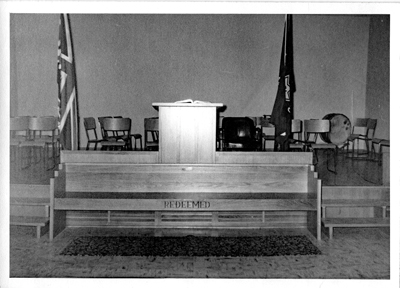 It was a humbling experience to use my gifts in this setting. I spent a lot of time thinking about the design, mulling over ideas, drawing out rough sketches and reaching out to other corps for photos. Eventually, I decided on two stand-alone pieces that could be moved if needed. As I worked in my shop, there were moments when I stopped to pray, thinking of those who would kneel here.
It was a humbling experience to use my gifts in this setting. I spent a lot of time thinking about the design, mulling over ideas, drawing out rough sketches and reaching out to other corps for photos. Eventually, I decided on two stand-alone pieces that could be moved if needed. As I worked in my shop, there were moments when I stopped to pray, thinking of those who would kneel here.
Our “new” mercy seat has a rich heritage. When Hampton Citadel closed to join Heritage Park Temple, I saved a piece of the old mercy seat, knowing it would be used again one day. In talking with Gary Robson, I discovered that this simple piece of wood, engraved with the word “Redeemed,” can be traced back even further. It was originally part of the mercy seat at the now-closed Ellice Avenue Corps, where it was dedicated in memory of his grandparents, Corps Sergeant-Major Charles and Minnie Robson, in 1957. So it has been part of our history for more than half a century.
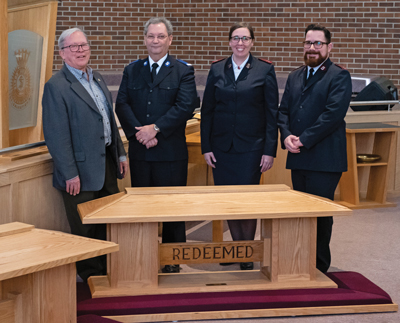 From left, Gary Robson, Paul Nelson and Cpts Tina and Josh Howard, corps officers at Heritage Park Temple in Winnipeg, with the restored mercy seat
From left, Gary Robson, Paul Nelson and Cpts Tina and Josh Howard, corps officers at Heritage Park Temple in Winnipeg, with the restored mercy seat
I pray that we will not just look at it, but use it as a place of dedication, commitment and prayer—not only in times of trouble, but also in times of rejoicing or to simply come and pray. Through it all God has been here and will be here, communing with us and guiding us as we continue to strive to bring his message of faith, hope and love to the people of our community.




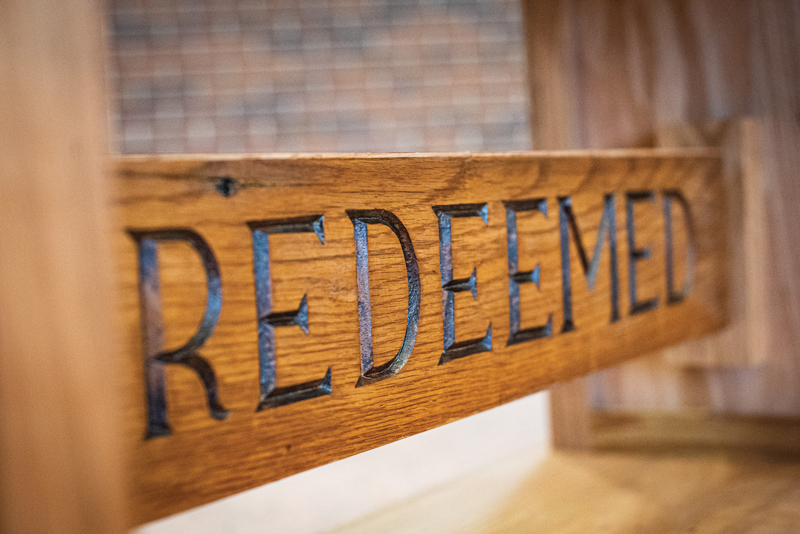
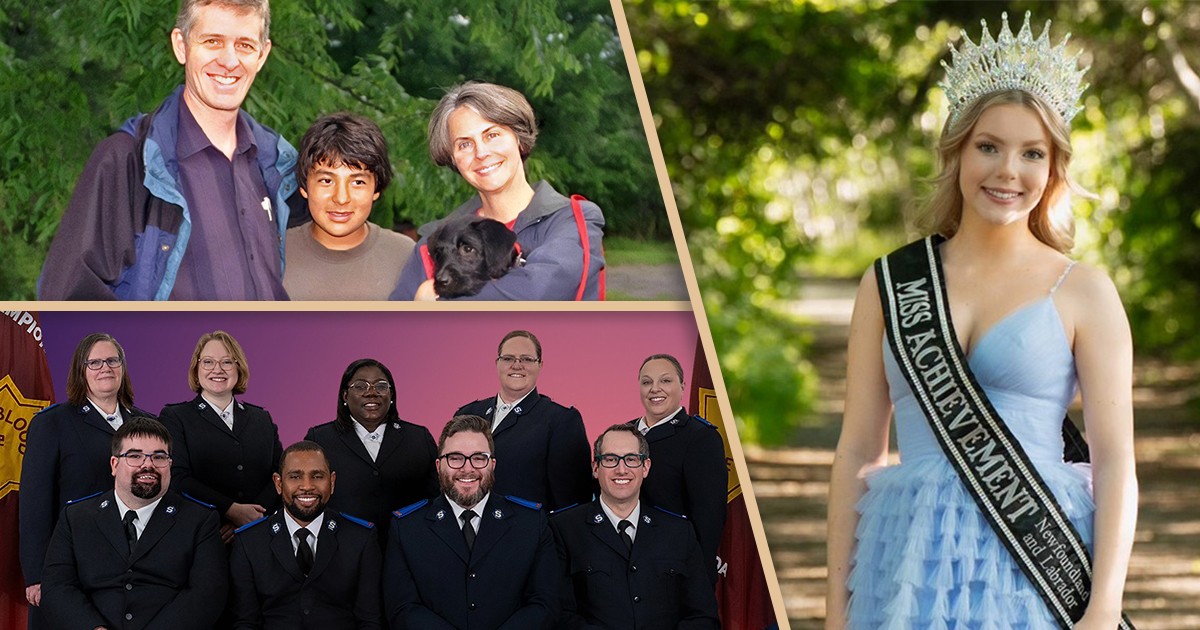
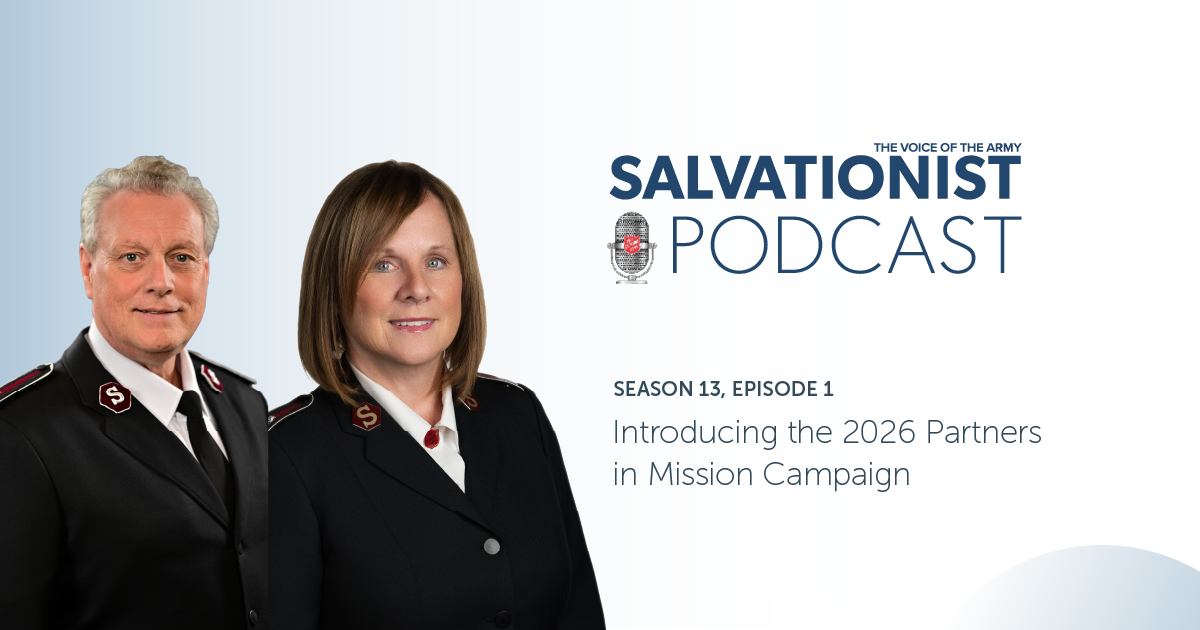



Comment
On Tuesday, January 28, 2020, L. Manley said:
On Saturday, January 25, 2020, Pastor Joyce Johnson said:
Leave a Comment